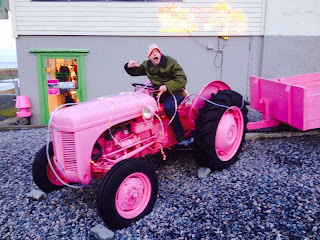I’m not sure how old I was when these first
floated into my consciousness, but it would have been at some point in the late
eighties when I was at primary school and gradually beginning to focus my
attention outside of my childish circle of friends and activity into the
mysterious world of adults.
The tins (tinnies): marvellous in their
ranked uniformity: the front of the can
emblazoned with that bold red T with the turned down ends on the top and the
sky blue background perfectly setting off the foamy-topped glass of amber
liquid, and then, like a conjuring trick, you’d circle round the display in
Prestos Supermarket (radio jingle: “You’ll be impressed in Presto!”) to see the
many and varied lovelies on the back. How many of them were there? I never had
a sense of it. Linda and Kelly and Janis and all those other reassuringly bland
names. Who were they? Where did they come from? What did their mammies and
daddies think about them being on the back of a beer can?
Even at that young age the cans provoked a
deep curiosity accompanied by a simultaneous deep unease in me. On the one hand
I liked looking at the lovelies (of course, that was the whole point of them) –
their helmets of moussed hair, so fashionable in those days; the Bowieseque
streaks of harsh pink blusher (considered so tacky now, but the absolute height
of fashion then); and their exotic outfits, sometimes reassuring, like a fluffy
pink sweater, other times risqué verging on the pornographic – baby blue satin
nightgowns or glimpses of lingerie, utterly exotic when all you’ve seen is you
and your mam’s faded sensible knickers hanging on the line. But along with the
titillation and the aesthetic pleasure of looking at pretty young women there
was something else – something that I wasn’t then able to put into words or form
into a coherent question. I was taken up by the who and the what – who was
Linda and what was she wearing? But the questions I was unable to form were all
why – why were these women on the back of beer cans? Why were some of them
wearing fancy (I didn’t yet know the word ‘sexy’) clothes? Why were there no
men on the back of the cans?
There was something highly collectible about
the tins, which as a child I understood very keenly. These cylindrical tubes,
each with their shiny pretty lady on the back were the next step up from the
Paninni stickers we traded in the playground. I imagined the men who bought the
cans arranging them in similar pyramidal displays on their mantelpieces, sitting
swigging their Tennents and looking at their collection of lovelies. I thought
about what they might be thinking as they looked at their tinnies and I felt
strange and uncomfortable inside. I knew it was best not to ask anyone about
what this meant.
But there were things I dimly understood.
Tennents and tinnies in general were for men, which meant that the pictures of
the lovelies were for men, not for ladies. It was a bit embarrassing to look at
them, to think about what Mam and Dad would say if they caught me sneaking
peeks them. But then, why were they there in big displays in Prestos? You
couldn’t not look at them! I’d seen the dirty magazines hidden away on the top
shelves of newsagents and somehow I knew these tinnies, although they were on
display right in front of the main doors of the town supermarket just like
Fairy Liquid and Daz, were from the same family of items as those magazines, and that there was something not quite right going on, something that made my dull little local supermarket, in my grubby little seaside hometown, suddenly feel like a hostile environment.
To this day I’ve never had even a sip of
Tennents – partly out of a class-based snobbishness (somehow I’m sure it won’t
taste as good as the cold crisp expensive Italian lagers I love) but also
because of the invisible gender-based taboo that was imprinted within me during
the run of that advertising campaign. I wasn’t then aware of the grim drinking
culture that existed in Scotland, or how masculine it was. My dad didn’t drink
Tennents and my grandpa preferred to drink his beer draught, in the company of other
people at the local pub. It wasn’t until I was a teenager that I became aware
of the tradition of the ‘carry out’ – and the fondness for Scots to sit drinking
tin after tin in their own houses, or to build my imagined pyramids of empty
cans on every available surface in the living room and kitchen.
The campaign ended in 1991, apparently, when I was 13. I suspect it had started to look a little gauche in the wake
of lads’ magazines and Eurotrash. I feel no nostalgia for the Tennents
lovelies, but perhaps some misplaced admiration for the campaign strategists
that took the objectification of women to its logical apex, and persuaded an
entire nation for several decades to unthinkingly sling Linda, Kelly and Janis
into their baskets alongside their toilet rolls and discount dogfood. Cheers.





